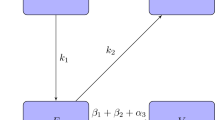Abstract
In this paper, we have proposed and analyzed a nonlinear mathematical model for control of unemployment in the developing countries by incorporating time delay in creating new vacancies. In the modeling process, three dynamic variables have been considered, namely, (i) number of unemployed persons, (ii) number of employed persons, and (iii) number of newly created vacancies. The model is studied using stability theory of differential equations. It is found that the model has only one equilibrium, which is stable in absence of delay. It is further shown that this stable equilibrium becomes unstable as delay crosses some critical value. This critical value of delay has been obtained analytically. Further, direction of Hopf bifurcation and stability of the bifurcating periodic solutions are studied by applying the normal form theory and the center manifold theorem. Numerical simulation of the model has been carried out to illustrate the analytical results.




Similar content being viewed by others
References
Chowdhury, S.: Employment in India: what does the latest data show? Econ. Polit. Wkly. XLVI, 23–26 (2011)
Freedman, H.I., Rao, V.S.H.: The trade-off between mutual interference and time lags in predator-prey systems. Bull. Math. Biol. 45, 991–1004 (1983)
Global Employment Trends: International Labour Office, Geneva, ILO (2012). Available at www.ilo.org/publns. Retrieved on 5 Oct 2012
Gopalsamy, K.: Stability and Oscillations in Delay Differential Equations of Population Dynamics. Kluwer, Dordrecht (1992)
Hassard, B.D., Kazrinoff, N.D., Wan, W.H.: Theory and Application of Hopf Bifurcation: London Math Society Lecture Note Series, vol. 41. Cambridge University Press, Cambridge (1981)
Misra, A.K., Singh, A.K.: A mathematical model for unemployment. Nonlinear Anal. RWA 12, 128–136 (2011)
Nikolopoulos, C.V., Tzanetis, D.E.: A model for housing allocation of a homeless population due to a natural disaster. Nonlinear Anal. RWA 4, 561–579 (2003)
Acknowledgments
Authors are thankful to the handling editor and both the referees for their useful suggestions, which have improved the quality of this paper.
Author information
Authors and Affiliations
Corresponding author
Rights and permissions
About this article
Cite this article
Misra, A.K., Singh, A.K. A Delay Mathematical Model for the Control of Unemployment. Differ Equ Dyn Syst 21, 291–307 (2013). https://doi.org/10.1007/s12591-012-0153-3
Published:
Issue Date:
DOI: https://doi.org/10.1007/s12591-012-0153-3




